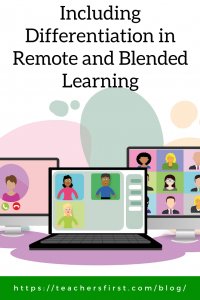 This year has tested traditional education models in ways that no one expected. Who knew that almost overnight educators would have to learn new ways of delivering instruction beyond the classroom walls while still meeting the differing needs of all students?
This year has tested traditional education models in ways that no one expected. Who knew that almost overnight educators would have to learn new ways of delivering instruction beyond the classroom walls while still meeting the differing needs of all students?
Even when thrown into new teaching environments, it is essential to differentiate learning for a variety of reasons, not least of which is to meet IEP goals and objectives for gifted learners. Another new factor is the necessity of meeting the emotional needs of students who now face challenges due to new learning situations.
Why does it matter?
The big reason that differentiation is essential is that it works. It provides all of our learners the opportunity to be successful within their ability levels while still providing growth opportunities. It works because it is student-centered; educators use various assessments to understand individual student abilities and interests so they can design educational materials that are engaging, relevant, and appropriate.
Terms to know:
- Remote learning – A scenario where the instructor and student are separated by time, distance, or both.
- Synchronous learning – Learning events where learners participate together at the same time
- Asynchronous learning – Activities where students learn the same information but at different times and in different places.
- Blended learning – Learning, according to org, that is provided through both online experiences and face-to-face learning that connects the two learning experiences to provide an integrated learning model.
- Differentiated instruction – Tailored instruction that fits individual students’ needs using various techniques, including adjusting content, the learning process, the learning environment, or the product.
Where can I find free resources?
Take a quick look at a Google search for any of these terms. There are many different ideas for products, professional learning and development, and lesson ideas, but the amount of information is overwhelming. TeachersFirst®️ has done a lot of the hard work for you by putting together some of the best resources within specific categories that fit a variety of educational needs.
Resources for Teaching Remotely ––This collection shares instructional ideas, tips, and how-to information to help you get started teaching remotely. It is an excellent starting point for any educator who needs support and is looking for ideas for use across grade levels and content areas.
Blended Learning Resources – This curated list of resources includes suggestions for online resources that work well with blended learning situations and includes sites for creating presentations, videos, and learning games. It also shares tools for extending learning by adding quizzes and questions into videos and creating learning paths using online lesson delivery systems like TES Blendspace (TeachersFirst review) and Actively Learn (TeachersFirst review).
Game-Based Learning Resources – Using games as a teaching tool not only engages learners, but also provides an excellent opportunity for differentiation through the use of different levels and gameplay strategies. The game-based resources in this Special Topics collection provide various options for all grade levels and content areas.
BYOD Dream Tools: Free Tools that Work on ANY Device! – Nothing is more frustrating than trying to use technology and finding that it doesn’t work the same for all users. This list includes free tools that work across all devices and platforms to save you time and headaches.
Differentiating Instruction: Ideas for individual Differences Page – As discussed earlier, there are many ways to differentiate instruction. This page on TeachersFirst includes ideas for differentiation for all students, including suggestions for specific student needs, such as autism and Aspergers, ESL/ELL, gifted, and special education students.
Nourishing Gifted Through Technology in Any Classroom – With all of the testing required in today’s classroom, and the implementation of standards-based curriculums, it is vital to remember the needs of our gifted learners. This resource shares ideas and strategies for nourishing the needs of gifted learners and shares some “sanity savers” to help organize both you and your students.
Challenge yourself to differentiate learning for all students
Maintaining an effective learning environment within our new teaching realities is a challenge, but not an impossible one. Consider taking this challenge head-on by developing your understanding of the many positive reasons for using blended learning techniques even when you return to a four-wall classroom. Embrace the ideas and resources for differentiating instruction for all students because it works in developing successful and engaged students who become active parts of their learning process.
How are you doing with blended learning and differentiation? Do you have suggestions to share with our readers? We would love to hear your ideas for engaging all learners. Share them in the comments below.


Nice article! Thanks for sharing this informative post. Keep posting!